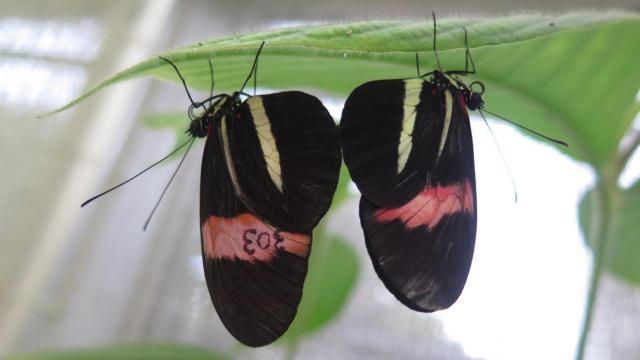A chemical produced by the male genitals of this tropical butterfly is so repulsive, scientists refer to it as an “anti-aphrodisiac.”
New research published today in PLOS Biology describes the genetic underpinnings of a chemical compound produced by male Heliconius melpomene butterflies. It’s a striking example of chemical signalling, in which scent is used for communication. In this case, the chemical, called ocimene, “acts as an anti-aphrodisiac pheromone, transferred from males to females during mating to repel further courtship from subsequent males,” write the authors in their paper.
Fascinatingly, some plants also produce ocimene, but they use it for a different purpose. The new research is highlighting a unique case of convergent evolution. In addition to identifying the genes in Heliconius melpomene responsible for producing the chemical, it’s the first time that scientists have documented the production of this chemical, a terpene, in an animal.
Accordingly, the new research dispels the prior belief that Heliconius melpomene sourced ocimene from plants (experiments done in 2007 showed that females covered with ocimene were approached less frequently by males than those covered in a control substance). As the new research shows, however, these butterflies can make this chemical all by themselves.
Members of Heliconius melpomene have extraordinarily long lifespans for butterflies, living for around six months as opposed to the usual one month. They live in Central and South America and exhibit a wide range of wing colour patterns, depending on their geographic location. These butterflies are toxic, so the patterns act as a warning to would-be predators. These patterns also play a role in sexual selection, as butterflies of this species choose mates that look like themselves.

“While the patterns have attracted the most attention, it has also long been noted that these butterflies smell,” explained Kathy Darragh, lead author of the new paper, in an email. “We now know that this smell is involved in mate-guarding, acting as an anti-aphrodisiac to repel future mating attempts from other males.” Darragh carried out this research while doing her PhD at the University of Cambridge.
Humans are very visual creatures, but many animals depend on chemical signalling as their main form of communication. Orchids, for example, mimic the scent of female insects to attract males for pollination. Anti-aphrodisiacs have also been documented in other insects, including burying beetles and plant bugs.
Butterflies, with their striking colours and patterns, clearly use visual cues to communicate, but that doesn’t mean they don’t also use chemicals. Darragh, now with UC Davis, wanted to investigate how chemical signals can play a role in butterfly communication.
“An interesting aspect of this, which was the focus of the current study, is how butterflies can make these chemicals which they use in signalling,” she said. “In other words, what genes do butterflies have which allow them to make these compounds? And are these the same genes used to make these compounds in plants?”
Indeed, ocimene is also produced by tropical plants to attract butterflies for pollination (more on this apparent contradiction in just a bit). This is an example of convergent evolution, in which two independent species evolve a similar trait. What’s unique about this finding, however, is that plants and insects use this chemical for different purposes (though still for chemical signalling), and plants and insects use different genetic mechanisms to produce it. In the new paper, the researchers identified a novel gene in Heliconius melpomene responsible for ocimene, which is unrelated to previously described genes in plants with the same function.
“The production of ocimene has independently evolved via different genes in plants and butterflies, demonstrating how different molecular mechanisms can underlie the production of a specific chemical compound,” said Darragh. “The independent evolution of the same trait, in this case pheromone production, multiple times, provides a great system to help us understand evolution.”
That plants use ocimene to attract insects, but this butterfly uses it as a repellent, is a strange observation. The authors don’t fully understand why, but they think it might have something to do with the way visual and olfactory information works together. In other words, context matters; a butterfly interprets the chemical as an attractant when it’s coming from a plant but as an anti-aphrodisiac when its coming from another butterfly. The “scent itself doesn’t vary,” said Darragh, “but the context, and therefore how the signal is interpreted, does.”
All this is fine and well, but if a male successfully mates with a female, why should he care about other suitors? The answer is that female Heliconius melpomene store sperm for months, during which time they patiently fertilize their eggs. Subsequent mating episodes would introduce new sperm. This has resulted in the observed male-on-male competition and this bizarre arms race involving stinky genitals.
[referenced id=”1665111″ url=”https://gizmodo.com.au/2021/01/drowned-out-by-noise-these-horny-frogs-wave-their-arms-and-legs-to-get-noticed/” thumb=”https://gizmodo.com.au/wp-content/uploads/2021/01/16/asvojgxwy9l8q0nj616v-300×168.jpg” title=”Drowned Out by Noise, These Horny Frogs Wave Their Arms and Legs to Get Noticed” excerpt=”A species of Ecuadorian glass frog combines high-frequency croaking and a striking visual display to attract mates, in what is a fascinating adaptation to a noisy environment.”]
This gets even weirder, because it creates scenarios in which eager females would very much like to hook up, but the males want nothing to do with them. Think of it as an insectoid version of sexual frustration.
At the same time, however, Darragh believes it may actually work out to the females’ advantage. The “anti-aphrodisiacs can also act as honest signals of receptivity, reducing harassment by males while females are unreceptive to further matings,” she said. This is beneficial to both males and females, as “males don’t waste time courting unreceptive females, and females can reduce harassment by males.”
I feel there’s an important lesson here for us humans, but I can’t quite place my finger on it.
